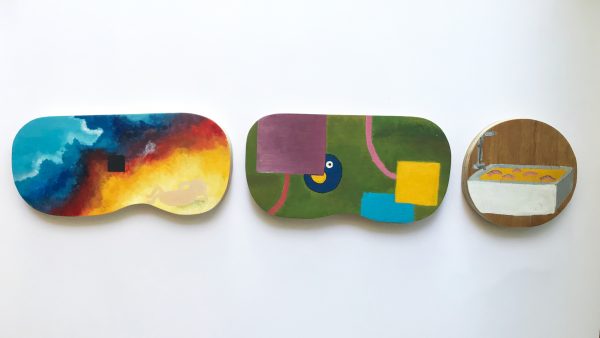About the artist: Cherie Wong is in her final semester completing a double Bachelor of Arts degree from the School of Creative Media, the City University of Hong Kong. and Leuphana University Lüneburg (Germany). Rooted in her interest in psychoanalysis, her graduation thesis is a research-creation over many months of drawing images automatically on wood pieces. Automatic methods would not reveal the totality of our unconscious, but they allow instantaneous access and fragments of our hidden consciousness to surface. Cherie Wong calls this a game of communication with herself. Some of the automatic and dream drawings are presented here, and her notes is just the beginning of a long creative journey to stretch the generative potentials of her 100 pieces of drawing, a special way to make sense of herself, and to tap potential connectivity with other individuals.
一直都很好奇自己「不做第一,也不做最後」得過且過的性格是從那裡來的,是怎樣建立而成的。好奇心驅使之下,走了去讀佛洛依德的理論,心理分析、潛意識和夢,希望能從中找到答案。答案雖然並沒有乖乖按劇本理所當然地走出來,但我卻找到另一個切入點去看這個問題。
I have always been curious about how my personality and thoughts have been established and shaped. To understand more about it, I got into some Freudian concepts — psychoanalysis, unconsciousness and dreams interpretation. Our unconscious mind undeniably contains a huge number of clues on the formation of our mindsets. Thus, I thought of doing psychoanalysis for myself to understand more about it, and yet I later found out that it is impossible to do psychoanalysis on my own.
Sigmund Freud introduced psychoanalysis in the early 1900s. Psychoanalysis is not only theories, it was developed into a therapeutic technique to cure mental illness. Among the many aspects, it suggests that forgotten childhood stories greatly affect the formation of personality and the unconscious mind hugely influences our behaviours and thinking. However, psychoanalysis cannot be performed by oneself as the process involves weakening one’s ego, which is a guard to prevent the undesired thoughts from entering consciousness, to get to know the “genuine” ideas in the unconscious mind. After understanding the impossibility in carrying out psychoanalysis on my own, I was struggling what to focus on to solve this question. And a chat with my dad inspired me. He mentioned he had once read a metaphor of everyone’s mind is like a house where a monster, which is like our undesired thoughts, lives in the locked loft. I then, therefore, turned to my little monster, unconscious mind. In the sea of unconsciousness, dreams are great material to start this exploration.
I made attempts to discover my unconscious mind through visualizing my dreams, to create a bigger space for imagination, comprehension and conversation. While drawing them out, random associations just popped up naturally, without any deliberate interpretation. This sparkled communication within me. According to Freud, these associations are nonetheless part of the latent totality of our dream-thoughts, which has no direct correspondence with my interpretations. That is to say, there is no definite meanings to these ideations except my interpretation through my voluntary association. The process of preparing these drawings indeed serves as a live channel for me to talk to my inner self and gather traces of my thought world.

Drawing out my dreams is also a process of un-building, which granted me a chance to unearth the fragmented thoughts inside me and reminisce some almost forgotten childhood stories. We could only inspect the details of the dreams bit by bit to scrutinize the hidden meaning or the related incidents, but never get a thorough interpretation of them. Dream content is also not the only determining sources in comprehending the latent dream- thoughts, personality and the stage of life where I am are critically important as well. Even if two persons are having the same dream, the latent meanings are totally different. As there is no straight rule to how to interpret one’s dreams, the exploration of my dreams is indeed a playful journey for me to communicate with my interiority.

Along the journey, I got to recognize the importance of communication. Midway through my journey, I gave myself a box to delimit my expressive possibilities by creating certain rules for myself out of nowhere. When communications came in, problem resolved accordingly. We can never get the right answers to our dreams, yet we can chat with ourselves with the clues that we get from our dreams. We might discover something more. Before, being a citizen here in this hustling metropolis, I seldom spend time to look right into my world of thoughts. The “quarantine” period also reminds me that “me time” brings in time for in-depth communications. Even if sometimes we can remember the dreams of the previous night, we seldom dig into them. So, the journey is also an act of opening the door.

After decades of development, the unconscious mind remains mysterious. There are parts that are hard to be investigated scientifically as thoughts are not concrete images or videos. We can never fully understand our dreams nor our unconsciousness, there are always unknowns and fascinating. It is also suggesting that we can barely understand ourselves.
Personality is a vague and broad question affected by various things, including unconsciousness and environment. So I acknowledge that unconsciousness is something that I could not comprehend wholly at all. My initial question – how my personality is being formed – has not been resolved, yet it points me to another perspective with a different outlook: communication is the key to understand. Instead of wanting to understand yourself fully, communications can be the only way to sparkle more ideas from our inner self. As an urbanite, we seldom spend quality time with our mind, instead of wanting to understand ourselves fully, let’s keep communication open.
(12 September 2020)




